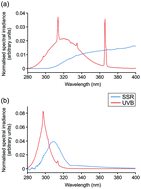当前位置:
X-MOL 学术
›
Photochem. Photobiol. Sci.
›
论文详情
Our official English website, www.x-mol.net, welcomes your feedback! (Note: you will need to create a separate account there.)
Differential reorganisation of cutaneous elastic fibres: a comparison of the in vivo effects of broadband ultraviolet B versus solar simulated radiation
Photochemical & Photobiological Sciences ( IF 3.1 ) Pub Date : 2018-04-26 00:00:00 , DOI: 10.1039/c7pp00412e Nisamanee Charoenchon 1 , Lesley E Rhodes , Suzanne M Pilkington , Mark D Farrar , Rachel E B Watson
Photochemical & Photobiological Sciences ( IF 3.1 ) Pub Date : 2018-04-26 00:00:00 , DOI: 10.1039/c7pp00412e Nisamanee Charoenchon 1 , Lesley E Rhodes , Suzanne M Pilkington , Mark D Farrar , Rachel E B Watson
Affiliation

|
Long-term exposure of human skin to ultraviolet radiation (UVR) in sunlight negatively impacts its appearance and function with photoaged skin having a characteristic leathery, rough appearance, with deep wrinkles. These clinical features of photodamage are thought to result from UVR-induced remodelling of the dermal extracellular matrix, particularly the elastic fibre system. There are few in vivo human data on the impact of acute UVR exposure on this fibre system and particularly solar-simulated radiation (SSR)-mediated effects. We examined the differential effect of broadband UVB and SSR on the human dermal elastic fibre system, and specifically the microfibrillar components fibrillin-1, fibulin-2 and fibulin-5. Healthy white Caucasian adults (skin type II–III) were recruited and irradiated with 3× their minimal erythema dose of broadband UVB (n = 6) or SSR (n = 6) on photoprotected buttock skin. Punch biopsies were taken 24 h after irradiation and from unirradiated control skin. Overall, histological assessment of elastic fibres revealed significantly less elastic fibre staining in broadband UVB (P = 0.004) or SSR (P = 0.04) irradiated skin compared to unirradiated control skin. Significantly less staining of fibrillin-1-positive microfibrils was also observed in the papillary dermis of UVB irradiated skin (P = 0.02) but not skin exposed to SSR. Conversely, immunohistochemistry for fibulin-5-positive microfibrils revealed significantly less expression in skin exposed to SSR (P = 0.04) but not to broadband UVB. There was no significant change in fibulin-2-positive microfibrils following either broadband UVB or SSR irradiation. Thus, broadband UVB and SSR mediate differential effects on individual components of the dermal elastic fibre network in human skin. Further human studies are required to explore the mechanisms underlying these findings and the impact of potential photoprotective agents.
中文翻译:

皮肤弹性纤维的差异重组:宽带紫外线 B 与太阳模拟辐射的体内效应比较
人体皮肤长期暴露在阳光中的紫外线 (UVR) 下会对皮肤的外观和功能产生负面影响,光老化的皮肤会呈现典型的皮革般、粗糙的外观,并有很深的皱纹。光损伤的这些临床特征被认为是由紫外线诱导的真皮细胞外基质,特别是弹性纤维系统的重塑造成的。关于急性紫外线照射对这种纤维系统的影响,特别是太阳模拟辐射 (SSR) 介导的影响,体内人体数据很少。我们研究了宽带 UVB 和 SSR 对人体真皮弹性纤维系统的不同影响,特别是微纤维成分 fibrillin-1、fibulin-2 和 fibulin-5。招募健康白人白人成年人(皮肤类型 II-III),并用 3 倍其最小红斑剂量的宽带 UVB ( n = 6) 或 SSR ( n = 6) 照射受光保护的臀部皮肤。照射后 24 小时,从未照射的对照皮肤上进行穿刺活检。总体而言,弹性纤维的组织学评估显示,与未照射的对照皮肤相比,宽带 UVB ( P = 0.004) 或 SSR ( P = 0.04) 照射的皮肤中的弹性纤维染色明显较少。在 UVB 照射的皮肤的乳头状真皮中也观察到原纤维蛋白 1 阳性微纤维的染色显着减少 ( P = 0.02),但在暴露于 SSR 的皮肤中则不然。相反,fibulin-5 阳性微纤维的免疫组织化学显示,暴露于 SSR 的皮肤中表达显着较低(P = 0.04),但暴露于宽带 UVB 的皮肤中则不然。宽带 UVB 或 SSR 照射后,fibulin-2 阳性微纤维没有显着变化。因此,宽带 UVB 和 SSR 对人体皮肤中真皮弹性纤维网络的各个成分产生不同的影响。需要进一步的人体研究来探索这些发现背后的机制以及潜在光保护剂的影响。
更新日期:2018-04-26
中文翻译:

皮肤弹性纤维的差异重组:宽带紫外线 B 与太阳模拟辐射的体内效应比较
人体皮肤长期暴露在阳光中的紫外线 (UVR) 下会对皮肤的外观和功能产生负面影响,光老化的皮肤会呈现典型的皮革般、粗糙的外观,并有很深的皱纹。光损伤的这些临床特征被认为是由紫外线诱导的真皮细胞外基质,特别是弹性纤维系统的重塑造成的。关于急性紫外线照射对这种纤维系统的影响,特别是太阳模拟辐射 (SSR) 介导的影响,体内人体数据很少。我们研究了宽带 UVB 和 SSR 对人体真皮弹性纤维系统的不同影响,特别是微纤维成分 fibrillin-1、fibulin-2 和 fibulin-5。招募健康白人白人成年人(皮肤类型 II-III),并用 3 倍其最小红斑剂量的宽带 UVB ( n = 6) 或 SSR ( n = 6) 照射受光保护的臀部皮肤。照射后 24 小时,从未照射的对照皮肤上进行穿刺活检。总体而言,弹性纤维的组织学评估显示,与未照射的对照皮肤相比,宽带 UVB ( P = 0.004) 或 SSR ( P = 0.04) 照射的皮肤中的弹性纤维染色明显较少。在 UVB 照射的皮肤的乳头状真皮中也观察到原纤维蛋白 1 阳性微纤维的染色显着减少 ( P = 0.02),但在暴露于 SSR 的皮肤中则不然。相反,fibulin-5 阳性微纤维的免疫组织化学显示,暴露于 SSR 的皮肤中表达显着较低(P = 0.04),但暴露于宽带 UVB 的皮肤中则不然。宽带 UVB 或 SSR 照射后,fibulin-2 阳性微纤维没有显着变化。因此,宽带 UVB 和 SSR 对人体皮肤中真皮弹性纤维网络的各个成分产生不同的影响。需要进一步的人体研究来探索这些发现背后的机制以及潜在光保护剂的影响。



























 京公网安备 11010802027423号
京公网安备 11010802027423号